Pierce Haviland and the G-Motor
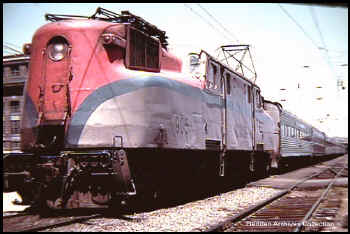
An Amtrak-era GG-1 in Red, Blue and Silver, prepares to depart New Haven.
Its possible Pierce Haviland was the engineer.
Photo © Bob Redden
THE GG-1 LOCOMOTIVE WAS DESIGNED BY THE PENNSYLVANIA RAILROAD in the 1930s, and later modified by industrial designer Raymond Loewy. 139 units were constructed between 1934 and 1943. The first unit to be built was easy to identify. Instead of a smooth side, it had rivets clearly visible on the exterior. You can see that engine today at The Railroad Museum of Pennsylvania. The motors were assembled by the Pennsylvania Railroad, Baldwin and General Electric with components supplied by Westinghouse. They were one of the first engines to use cab signals. I was lucky enough to run the GGs as a locomotive engineer before they were retired.
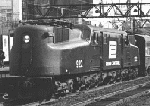 ...During one ride in the Penn Central era an
engineer asked me, "how fast do you think we are going?" The catenary poles on
the former New Haven were whizzing by. I said, "I don't know." He said,
"come look." I walked across the cab to peer at the speedometer. It was on the
pin at 100 mph. To this day, I don't know how fast we were actually going.
The picture at on the right was taken in New Rochelle station on the New
Haven Line some time during the 1970s of the Montrealer before
it headed down the Hell Gate Line to Penn Station.
...During one ride in the Penn Central era an
engineer asked me, "how fast do you think we are going?" The catenary poles on
the former New Haven were whizzing by. I said, "I don't know." He said,
"come look." I walked across the cab to peer at the speedometer. It was on the
pin at 100 mph. To this day, I don't know how fast we were actually going.
The picture at on the right was taken in New Rochelle station on the New
Haven Line some time during the 1970s of the Montrealer before
it headed down the Hell Gate Line to Penn Station.
...The best demonstration of the durability of the engine was in 1953. An angle cock had closed behind GG-1 4876 as it headed towards Washington's Union Station. This prevented the engineer from being able to stop the train with the air brakes. It crashed into the main waiting area. The 477,000 pound engine then plunged through the floor into the basement. The mess was covered up in time for the inauguration of President Eisenhower. The twenty year-old engine was then cut into three pieces and transported to Altoona, Pennsylvania. In Altoona, they put the engine back together! It went on to provide another 30 years of service. Now, that's durability.
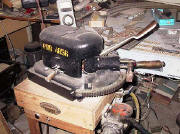 MY FIRST ASSIGNMENT AS A PASSENGER ENGINEER in 1976 was to run The
Montrealer from Penn Station to New Haven. It was Labor Day weekend and the train had two
GG-1s and 15 coaches! The throttle on the GG-1 had 22 notches (a standard diesel has eight
notches, take a look at the photo of a GG-1 throttle adapted for a model
train set). When you had two GGs hooked together, there was a bar that was placed over the
throttle to prevent going beyond the 18th notch. This was not done to protect the engine,
but to keep the substations from being overloaded. The lever sticking up at
a 45 degree angle was the deadman. You could hold it down with your hand, or
just keep your foot on the deadman pedal on the floor. Some lazy engineers
would slip a brake hose grommet over this bar to keep it held down. Today,
that could cost them $10,000 and a loss of their certification!
MY FIRST ASSIGNMENT AS A PASSENGER ENGINEER in 1976 was to run The
Montrealer from Penn Station to New Haven. It was Labor Day weekend and the train had two
GG-1s and 15 coaches! The throttle on the GG-1 had 22 notches (a standard diesel has eight
notches, take a look at the photo of a GG-1 throttle adapted for a model
train set). When you had two GGs hooked together, there was a bar that was placed over the
throttle to prevent going beyond the 18th notch. This was not done to protect the engine,
but to keep the substations from being overloaded. The lever sticking up at
a 45 degree angle was the deadman. You could hold it down with your hand, or
just keep your foot on the deadman pedal on the floor. Some lazy engineers
would slip a brake hose grommet over this bar to keep it held down. Today,
that could cost them $10,000 and a loss of their certification!
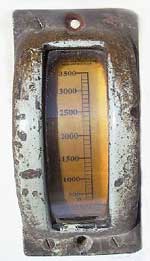 ...In 1976 the New Haven Line was still powered by its own
11,000 volt, 25 cycle power plant at Cos Cob (Greenwich) Connecticut. By the time the
juice made it to New Haven, the voltage was lower. Leaving New Haven en route to Penn
Station, you climb a steep grade in West Haven. With a long train, the power would drop to
the point where the lights would dim and the compressor would shut down. It was necessary
to ease off on the throttle to keep air supplied to the train. It kept an engineer busy
watching signals, amperage and air gauges.
...In 1976 the New Haven Line was still powered by its own
11,000 volt, 25 cycle power plant at Cos Cob (Greenwich) Connecticut. By the time the
juice made it to New Haven, the voltage was lower. Leaving New Haven en route to Penn
Station, you climb a steep grade in West Haven. With a long train, the power would drop to
the point where the lights would dim and the compressor would shut down. It was necessary
to ease off on the throttle to keep air supplied to the train. It kept an engineer busy
watching signals, amperage and air gauges.
...The GG-1 rarely broke down as there were few things that could go wrong. A main circuit breaker would trip when excessive power was used. It was simple to reset. There were two water tanks located on either end of the engine. Steam generators provided heat to the train. When the water tank near the steam generator ran low, the fireman had to transfer water from the other tank. To do this, you had to use steam to create a vacuum that would draw the water. Too much steam, or too little, would negate the siphon. The only way to tell if water was being transferred was to feel the pipe on the other side of the steam valve. When it became cool, you knew that the water was filling the pipe.
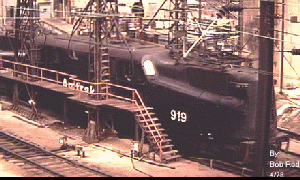 ...One
of the bad things about the GG-1 was the poor visibility for the engineer due to the long
nose extending beyond the cab. There were two cabs on the engine, one for each direction
of travel. One night I was leaving Penn Station with a young brakeman serving as my
fireman. As I left the platform with a restricting signal, I could not see the next
signal. I asked the fireman, "what's the next signal?" He replied, "which
one is ours?" I stopped the train and went over to look at the signal. It's a good
thing I did, as a Long Island Rail Road MU train pulled right in front of the
engine.
...One
of the bad things about the GG-1 was the poor visibility for the engineer due to the long
nose extending beyond the cab. There were two cabs on the engine, one for each direction
of travel. One night I was leaving Penn Station with a young brakeman serving as my
fireman. As I left the platform with a restricting signal, I could not see the next
signal. I asked the fireman, "what's the next signal?" He replied, "which
one is ours?" I stopped the train and went over to look at the signal. It's a good
thing I did, as a Long Island Rail Road MU train pulled right in front of the
engine.
...You can still get a look at a mothballed GG-1. There is one located near Hoboken Terminal in New Jersey and there are two and the Strasburg Railroad Museum. Since the motors were built to run on 25 cycle power, it is unlikely that you will ever see one restored to service. This would require a near-total replacement of the old electric components.
...While the GG-1 gave over half a century of fine service, General Electric has made a successful return to the passenger locomotive market. I am writing this story as I travel (as a passenger) at 110 mph en route to Albany being pulled by a Genesis Series 2 locomotive. The Genesis II is a dual mode engine that operates on both third rail and diesel. Will it be as successful as a GG-1? Ask me in fifty years!
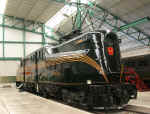 Be sure to visit Clint
Chamberlin's GG-1 Roster Page for more information about the G and where you can see
one. You can see the 4935, pictured at right, at the Pennsylvania State
Railroad Museum in Strasburg.
Be sure to visit Clint
Chamberlin's GG-1 Roster Page for more information about the G and where you can see
one. You can see the 4935, pictured at right, at the Pennsylvania State
Railroad Museum in Strasburg.
Click on the photo to get a better look.
![]() Who Is Pierce Haviland?
Who Is Pierce Haviland?
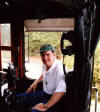 I
WAS RECENTLY EMPLOYED BY MTA METRO-NORTH
RAILROAD as Assistant Chief Training Officer. I began my railroad career as a fireman for Penn
Central in 1971. I was promoted through series examinations to engineer with Penn Central
in 1974. In 1976, I was promoted as a passenger engineer on the New
Haven Line for Conrail, operating freight,
commuter and Amtrak trains.
I
WAS RECENTLY EMPLOYED BY MTA METRO-NORTH
RAILROAD as Assistant Chief Training Officer. I began my railroad career as a fireman for Penn
Central in 1971. I was promoted through series examinations to engineer with Penn Central
in 1974. In 1976, I was promoted as a passenger engineer on the New
Haven Line for Conrail, operating freight,
commuter and Amtrak trains.
...I worked as a trainer of locomotive
engineers for over sixteen years
and have a BS in Management from SUNY Empire State College.
Other responsibilities I had included the operation of three locomotive simulators in
Grand Central Terminal. The simulators replicate the controls of Metro-North M4, FL9,
Genesis and
GP35 engines. An M-7 unit was added in 2004. The simulators are valuable tools in the training and certification of Metro-North,
Amtrak, CSX, Providence & Worcester and Canadian Pacific engineers. I
retired from the railroad in 2006.
| Home | Photo Index |
Please mail your comments to:
![]()
Last updated
November 10, 2010
